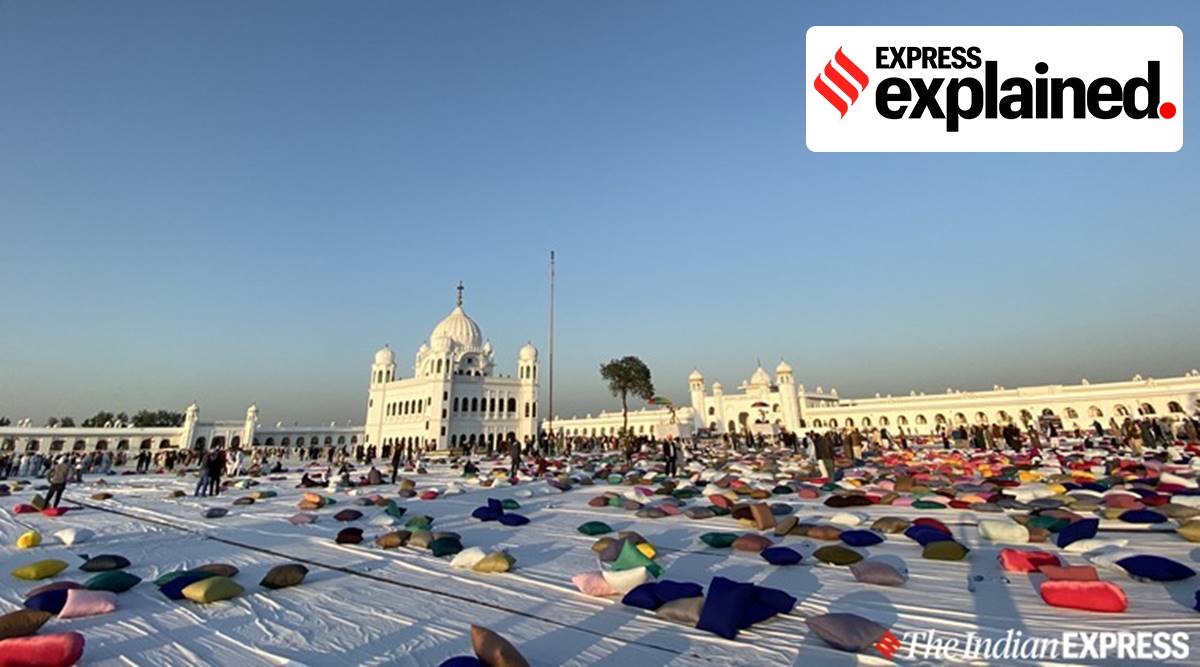The Indian Express explains the history of the shrine and the latest controversy.
The Pakistan government’s decision to transfer the management and administrative control of the Gurdwara Darbar Sahib in Kartarpur from a Sikh body — Pakistan Sikh Gurudwara Prabhandhak Committee (PSGPC) — to a trust under the Evacuee Trust Property Board, a non-Sikh body, has inviting sharp reactions from India, which termed the move “highly condemnable” and against the spirit of the Kartarpur Corridor. The Shiromani Akali Dal has termed Pakistan’s decision as a move to take full control of the gurdwara, which is also the final resting place of Sikh faith’s founder Guru Nanak Dev. The PSGPC, however, claims that there is no change in the administration of Gurdwara Darbar Sahib. The Indian Express explains the history of the shrine and the latest controversy.
What is Gurdwara Darbar Sahib and what is its importance in Sikh religion?
The Gurdwara Darbar Sahib, also known as Gurdwara Kartarpur Sahib, is located in Pakistan’s Narowal district across river Ravi, about five kilometres from the Dera Baba Nanak shrine in India’s Punjab. Guru Nanak Dev, the first Sikh Guru had arrived in Kartarpur between 1520 and 1522, as per historians, and spent the last 18 years of his life there. It was in Kararpur that he laid the foundations of a Sikh religion. At his final resting place stands the gurdwara. It was one of the most significant historical and spiritual place for Sikhs till 1947. Following the partition, no Sikh was left to take care of the gurdwara, which slowly turned into ruins and at one point of time was also used as a shelter by smugglers. One such person smuggled the Bir of Guru Granth Sahib left behind in the gurdwara and brought it back to east Punjab in late 60s.
? Express Explained is now on Telegram. Click here to join our channel (@ieexplained) and stay updated with the latest
The Gurdwara Darbar Sahib got Pakistan government’s attention in early 90s, when a Jatha of Sikh pilgrims from India highlighted its historical and spiritual importance. Pakistan government restored the main building of the gurdwara in 2004, after about decade-long repair works. In the meantime, a demand to construct a visa-free corridor to the gurdwara was raised and soon became a movement among Sikhs across the world. The Kartarpur Corridor was finally thrown open in 2019 with the two sides agreeing on visa-free travel for Indian pilgrims to the shrine. The corridor was shut in March this year in view of the coronavirus pandemic.
Who looks after management of gurdwaras in Pakistan?
There were more than 176 gurdwaras of religious and historical importance in Pakistan. Less than 20 of these gurdwaras have been opened so far by Pakistan government in last 73 years. All such gurdwaras are under control of Evacuee Trust Property Board (ETPB) of Pakistan.
“The ETPB looks after the building and maintenance of all Sikh gurdwaras in Pakistan whether they have been opened or still lying closed. The ETPB spends money from its own pocket. The Pakistan Sikh Gurudwara Prabhandhak Committee (PSGPC) looks after the religious affairs of the gurdwaras. The PSGPC also keeps control of the donations made by devotees. The ETPB has nothing to do with donations made by Sikhs at Darbar Sahib or any other gurdwara,” said Satwant Singh, president PSGPC.
Why the fresh controversy?
A controversy has erupted following a recent notification by ETPB as per which a new body — Project Management Unit (PMU) — has been formed for the administrative control of the Gurdwara Darbar Sahib.
Pakistan claims to have spent Rs 1,000 crore on the creating the Kartarpur Corridor infrastructure. It charges USD 20 from Indian pilgrims using the Corridor.
“The PMU is nothing new. Pakistan government acquired more than 800 acres of land for the expanded complex of Gurdwara Darbar Sahib and Kartarpur Corridor. So they need a separate body to look after all this structure spread over more than four kilometres. The ETPB also looks after the other gurdwara buildings in Pakistan. They don’t need separate body for all the other gurdwaras as infrastructure there is nothing when compared to the one created at Darbar Sahib. The new body (PMU) will not affect the role of the PSGPC in managing religious affairs at Gurdwara Darbar Sahib in anyway. Nothing has changed for us,” claims Satwant Singh.
On the Shiromani Akali Dal’s allegation that the new government body for Darbar Sahib has no Sikh member in it, which was “ a grave attack on fundamental rights of Sikh minority in Pakistan,” Satwant Singh said that there was no need of any Sikh member in the PMU. “The ETPB never makes any plan regarding gurdwaras without discussing with us. The PSGPC wants control over the religious affairs and we have that. It has always been like that. Nothing has changed.”
Satwant Singh said 18 gurdwaras in Pakistan are under PSGPC control. “The PSGPC collects and uses the donations that gurdwaras,” he says, reiterating that ETPB has nothing to do with money collected at Sikh shrines.
When did Pakistan government allow the SGPC to construct structures at Darbar Sahib?
Pakistan government had allowed Shiromani Gurdwara Parbandhak Committee (SGPC) — responsible for the management of gurdwaras in Punjab, Haryana, and Himachal Pradesh and union territory of Chandigarh — to perform ‘Kar Sewa’ (volunteer service) and construct new structures inside the premises of Gurdwara Darbar Sahib in 2015. At that time, the gurdwara had around 100 acre land. Main building of the Gurudwara was constructed in around 3 acre. Pakistan government has allowed SGPC to construct the buildings for community kitchen and other purposes around main building.
Source: Read Full Article


